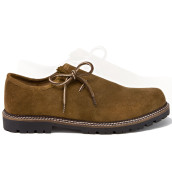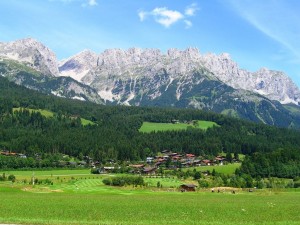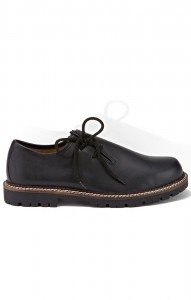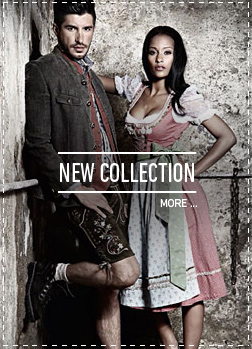Posted by trachten in Bavaria, Dirndl and Lederhosen | Comments Off on The Bavarian Haferlschuh: half a shoe?
The Bavarian Haferlschuh: half a shoe?

Almost everyone knows what they look like, but almost no-one knows what they’re called: “Bavarian shoes” or “lederhosen boots” are two of the descriptions we hear most often – and see as search enquiries that lead to our site. But of course, the real name for the shoes traditionally worn with Bavarian lederhosen is quite different: Haferlschuhe. There are also a couple of other German words for them – Bundschuh and, in Austria, Schützenbschuh.
Today, however, especially in Munich when talk turns to Oktoberfest wear, the word you are most likely to hear is Haferlschuh. It refers to a specific type of thick-soled shoe made of the same kind of leather as lederhosen, low cut around the ankle and with the laces set to the exterior sides of the feet. A popular classic, Haferlschuhe are generally bought to match the colour and texture of lederhosen, and so are available in camel or dark brown shades – rough, velour leather – or in black, smooth, polished leather.
Although the Haferlschuh is the undisputed classic of male Bavarian dress, however, it is unclear what its name is supposed to mean. It sounds like the German word for “oats” (Hafer)“, but patently has nothing to do with that species of plant. Neither can it be linked to hemp (). One theory is that it is a Bavarian dialect version of the word for hoof, Huf.
This latter etymology seems plausible inasmuch as the shoemaker from Oberstdorf said to have invented the shoe in around 1800, one Franz Schratt, based them specifically on the hooves of chamois mountain goats, the idea being to offer the wearer the same level of stability and sure-footedness as these alpine animals. However, most linguists dispute this version since the standard German U tends to become a UA diphthong in Bavarian, not a single A.
The theory which those in the know about Bavarian dialects prefer sounds, at first, far less probable indeed: the word Haferlschuh is actually borrowed from English! How can this most German piece of footwear carry an English name, though? The explanation is that the German Alps were popular with wealthy Brits in the mid-nineteenth century: aristocrats from across the country would flock to the Bavarian mountains to enjoy long hikes and make their first attempts at skiing, and soon discovered the practical nature of this (still relatively novel) shoe, adding it to their holiday wardrobes and christening them “half shoes”. Why “half”? Because the fashion of the day was for knee-length boots, especially in city wear, as the industrial conurbations of England and Scotland were famously insalubrious; in comparison to the kind of shoe or boot generally worn in Britain, therefore, the Bavarian shoe was really rather diminutive (however odd that may sound to our modern, trainer-clad selves).
As ever in this kind of question, of course, there can be no hard-and-fast answer, but the theory about “half-shoe” being Germanised into Haferlschuh has historical backing and is in fact the only version which cannot be ruled out by reference to linguistics. And if you can explain that to your Bavarian table companions a few beers in at next year’s Oktoberfest in a lively, entertaining, and accurate way, then you’ve truly earned the right to wear your Bavarian shoes!



